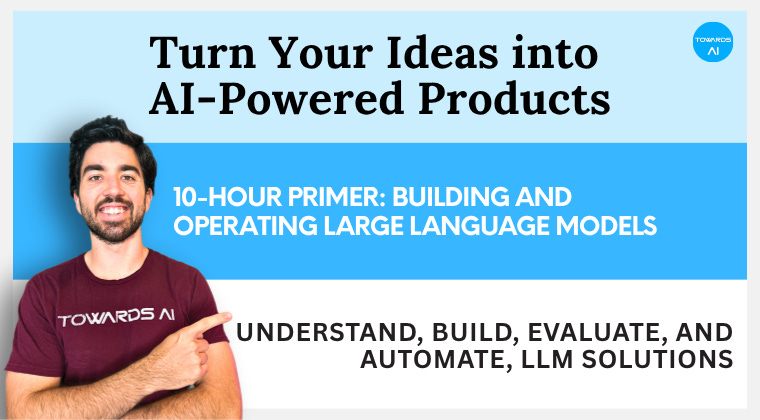Break Into AI With Tangible Proof of Skill
A 10-hour crash course built for anyone serious about using language models without getting lost in the hype.
After launching multiple LLM courses, building in-house tutors, consulting with enterprises, and supporting our community through real deployments, we’ve learned a few things:
Everyone knows they need to use LLMs.
Very few realize how broad and fragmented the space actually is.
In the end, everyone wants the same thing: to make their workflows, projects, or teams faster and smarter.
Execution doesn’t happen overnight. Our flagship programs take 60+ hours to get you to production. But most people don’t need to go that far, at least not right away.
They need to know where to begin. That’s what this course is for**. A fully video-based primer you can complete in a single day**, designed to give you clarity before you go deep.
Introducing the 10-Hour Video Primer: Building and Operating LLMs
The clearest, fastest path to understanding what really matters when building with language models.
This is the orientation you wish you had before your first prompt or repo.
We usually charge companies $25K–$50K to make these decisions. You’re getting the same clarity for just $199 (limited-time launch price).
I want to use LLMs in my work, but how do I even know what I need?
That’s the question nearly every smart, motivated learner begins with. This course is the answer.
We help you build a mental map of the LLM landscape so you know things like when to use RAG vs. fine-tuning, where agents fit in, and how to break down a use case so you know what to try first. Before you dive deep, this is the clarity that saves you weeks—and helps you build with confidence, not guesswork.
Exactly what it promises—a fast‑paced, no‑fluff immersion that cuts through the hype and shows you how large‑language models actually work and where they belong in real products and workflows…What I valued most was the practical toolkit: prompt‑engineering best practices, RAG versus long‑context trade‑offs, vector database basics, fine‑tuning essentials, security and privacy[...]. —Maddie Chalamangalam Sreeramulugari
In five 2-hour video sessions, you’ll:
Break down the transformer architecture—grasp attention mechanisms, context windows, and tokenization—and learn how these choices impact performance and model selection (open-source vs. proprietary).
Map out full-stack LLM pipelines, including advanced prompt engineering, RAG with vector databases, and supervised fine-tuning on task-specific data, so you can evaluate and prototype intelligently.
Evaluate what actually matters, combining automated metrics (BLEU, ROUGE, perplexity) with human-in-the-loop reviews and domain-informed test cases.
Dissect agent workflows and tool use, understanding when multi-step orchestration is warranted, how tools integrate via API calls or plugins, and how to keep costs and latency under control.
Master core optimization and safety principles, including model distillation, quantization, RLHF, and prompt injection mitigation—so your systems stay lightweight, safe, and production-ready.
By the end of the five in-depth video lessons, you’ll be able to understand, build, evaluate, automate, and maintain robust LLM solutions that are truly production-ready.
Although the course has a “for developers” focus, it’s relevant to everyone! No prior knowledge is required. A foundation in Python helps but isn’t essential to benefit from the training.
Before you become an expert, become someone who knows what to try first.
✅ 100% money-back guarantee within 30 days if you don’t feel more confident building with LLMs after the course.
What else should you know?
Fully video-based, self-paced
Lifetime access + all future updates
Private Discord with instructors + live Q&A
Certificate of completion for your resume or LinkedIn
Launch price: $199 (this will increase soon)
⚠️ Price Goes Up Soon
We’re adding a new 2-hour session on fine-tuning open models. If you enroll now, you’ll get it free—but the course price will increase once it's live.
👉 Start Your First Video Lesson
Learn faster. Avoid dead ends. And finally, understand what to do with LLMs.




